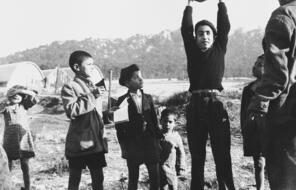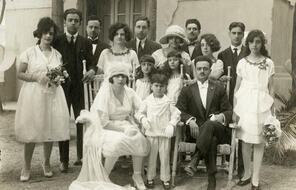Cultural Genocide
More than two decades ago, residential schools’ scholars such as James R. Miller and Indigenous leaders began to describe the efforts of the Canadian government to assimilate the Indigenous Peoples through the residential schools and other related policies as cultural genocide—arguing that assimilation was intended to destroy the Indigenous Peoples of Canada as a culturally distinct group. 1 Other scholars, mostly outside Canada, have noted that the cultural destruction of a group is not defined in the UN Genocide Convention as genocide (cultural genocide was excluded from the final document because of the objections of colonial states such as Australia, the United States, the United Kingdom, Canada, and France). 2
Scholar Steven Katz wrote about genocide in the specific context of the Holocaust and defined it narrowly as the intent to carry out “unmediated, intended, complete physical eradication of every Jewish man, woman and child.” Separating the Holocaust as a unique atrocity, Katz went on to argue that it “is this unconstrained, ideologically driven imperative that every Jew be murdered that distinguished the Holocaust from all prior anti-Semitism and, to this date, all subsequent, however inhumane, acts of collective violence." 3 Scholar David MacDonald explains that Katz and others therefore “exclude all other instances of genocide in world history, including the genocide of North America’s Indigenous peoples.” 4
Yet, for Raphael Lemkin, the man who coined the term genocide in his book Axis Rule in Occupied Europe, the cultural destruction of a group was as important as the physical annihilation of its members. According to Lemkin,
The world represents only so much culture and intellectual vigor as are created by its component national groups. Essentially the idea of a nation signifies constructive cooperation and original contributions, based upon genuine traditions, genuine culture, and well-developed national psychology. The destruction of a nation, therefore, results in the loss of its future contribution to the world. . . . Among the basic features which have marked progress in civilization are the respect for and appreciation of the national characteristics and qualities contributed to world culture by different nations—characteristics and qualities which . . . are not to be measured in terms of national power or wealth. 5
In 1946, when the newly founded United Nations began debating the creation of an international agreement for the prevention and punishment of genocide, it accepted Lemkin’s view. 6 The United Nations General Assembly, where these ideas were debated, then instructed one of its bodies to draw up a draft of this international agreement for its next session. A subsequent draft, written by the United Nations Secretariat, defined cultural genocide as “any deliberate act committed with the intention of destroying the language, religion or culture of a . . . group, such as, for example, prohibiting the use of the group’s language or its schools or places of worship.” 7 But, as international law expert William A. Schabas observes, the final version of Article 2 ended up being “a much-reduced version of the text prepared by the Secretariat experts.” To this day it does not mention cultural genocide. However, Schabas explains, the final version we have today includes “an exception to this general rule, allowing ‘forcible transfer of children from one group to another’ as a punishable act.” 8 In that sense, the Genocide Convention “categorized forcible child transfers as cultural genocide.” 9 David MacDonald argues that Article 2 (e) indeed brings the residential schools under the Genocide Convention without any need to alter its language. 10
Legality aside, why do so many activists and scholars now want to define forcible assimilation (as was carried out in the residential schools) as genocide? Political correspondent Mary Agnes Welch writes:
The idea of cultural genocide is particularly important for Canadian First Nations because few mass killings or instances of direct physical destruction occurred in Canadian history. But, there are many cases of policies whose indirect intent was to destroy culture at the very least, and First Nations would argue the upshot was the same—the end of them as a people. Tacking on the word “culture” somehow signals something was less than real genocide. Instead, scholars are arguing that destroying a group’s culture amounts to genocide plain and simple, with no need for a qualifier that softens the blow. 11
Sociologist Andrew Woolford of the University of Manitoba in Winnipeg explains in an interview:
If genocide should be understood as the “destruction of group life rather than lives within a group,” then in the case of Canada’s Indigenous peoples, that means understanding what makes them a group, what defines their cultural cohesion, such as a profound attachment to the land and nature. So, in Canada’s colonial past, systematically depriving First Nations of access to their land so European pioneers could settle and railways could be built, is genocidal. 12
Andrew Woolford, Adam Muller, and others therefore argue that if genocide is the targeting of a group’s existence as a group—that is, its “groupness”—then all acts designed to affect the group’s destruction—physical, cultural, political, economical, or otherwise—should be counted as genocidal. 13
Connection Questions
- What might Lemkin mean when he says, “The world represents only so much culture and intellectual vigor as are created by its component national groups”? How is that statement relevant to the destruction of the Indigenous Peoples as distinct groups?
- Why do you think Steven Katz separates the Holocaust from all other forms of ethnocide or mass atrocity? Compare Katz’s thinking about the idea of genocide with that of Lemkin and others in this reading. Where is there overlap? What differences do you notice? How do these ideas influence your thinking about the crimes that occurred as part of the ?
- Canada’s Department of the Interior stated in an 1876 report:
Our legislation generally rests on the principle, that the aborigines are to be kept in a condition of tutelage and treated as wards or children of the State. . . . [The] true interests of the aborigines and of the State alike require that every effort should be made to aid the Red man in lifting himself out of his condition of tutelage and dependence, and that is clearly our wisdom and our duty, through education and every other means to prepare him for a higher civilization by encouraging him to assume the privileges and responsibilities of full citizenship.
Lemkin states that “among the basic features which have marked progress in civilization are the respect for and appreciation of the national characteristics and qualities contributed to world culture by different nations.” How different is Lemkin’s notion of civilization from the colonial version discussed in the Department of the Interior report? How important is this discussion in determining what constitutes genocide? - The scholars Christopher Powell and Julia Peristerakis argue that we all have two identities: an individual identity and a collective identity. This idea was also expressed by sociologist Norbert Elias, who used the terms I-identity and we-identity to describe these dual identities.The we-identity, these scholars suggest, comes from the life of a group as a group, from the collective social and economic practices, from a shared tradition, and from the cultural institutions members of a group partake in. What happens when those practices are disrupted or destroyed? What happens to the group’s identity? What happens to it as a group? Why do you think Powell and Peristerakis, like others discussed in this reading, argue that the destruction of a group’s way of life amounts to genocide?
- Sociologist Andrew Woolford suggests that genocide should be defined as the “destruction of group life rather than lives within a group.” What might he mean by that? How different is this idea from Lemkin’s understanding of genocide? What do you think a conversation between Steven Katz and Andrew Woolford might include? What would each want to say to the other?
- Globe and Mail journalists Gloria Galloway and Bill Curry interviewed special adviser to the Truth and Reconciliation Commission John S. Milloy, who told them, “Some have been reluctant to use the word genocide out of concern that it would be seen as an attempt to equate Canada’s history with the genocide of Jews by the Nazis during the Second World War, although . . . the term cultural genocide is appropriate to the aboriginal experience in this country.” In what ways do the goals of the residential schools fit the idea of genocide, and in what ways do they not fit? What might Milloy have meant about some people being reluctant to call this genocide? Why?
- Is there a difference between genocide and cultural genocide, in your opinion? Does the addition of the word cultural matter?
- 1James R. Miller, Shingwauk’s Vision: A History of Native Residential Schools (Toronto: Toronto University Press, 2012), 9–10.
- 2Shamiran Mako, “Cultural Genocide and Key International Instruments: Framing the Indigenous Experience,” International Journal on Minority and Group Rights 19 (2012), 183.
- 3Steven Theodore Katz, Continuity and Discontinuity between Christian and Nazi Anti-Semitism (Tubingen: Mohr Siebeck, 2001), 74.
- 4David MacDonald, “Canada’s history war: Indigenous genocide and public memory in the United States, Australia, and Canada,” Journal of Genocide Studies, forthcoming, 2015.
- 5Raphael Lemkin, Axis Rule in Occupied Europe: Laws of Occupation - Analysis of Government - Proposals for Redress, 2nd ed. (Clark, NJ: The Lawbook Exchange, Ltd., 2005), 91.
- 6United Nations Resolution 96 (1), “The Crime of Genocide,” declared: “Genocide is the denial of the right of existence of entire human groups … Such denial of the right of existence shocks the conscience of mankind, results in great losses to humanity in the form of cultural and other contributions represented by these human groups, and is contrary to moral law and to the spirit and aims of the United Nations . . . The general assembly, therefore, affirms that genocide is a crime under international law … for the commission of which principals and accomplices . . . whether the crime is committed on religious, racial, political or any other grounds—are punishable.” United Nations Resolution 96 (1) ,“The Crime of Genocide,” United Nations website, accessed June 2, 2017. Emphasis added.
- 7Quoted in Kurt Mundorff, “Other Peoples’ Children: A Textual and Contextual Interpretation of the Genocide Convention, Article 2(e),” Harvard International Law Journal 50 (2009), 76.
- 8William A. Schabas, “Convention on the Prevention and Punishment of the Crime of Genocide,” United Nations Audiovisual Library of International Law, accessed June 17, 2015.
- 9Quoted in Kurt Mundorff, “Other Peoples’ Children: A Textual and Contextual Interpretation of the Genocide Convention, Article 2(e),” Harvard International Law Journal 50 (2009), 82.
- 10David B. MacDonald and Graham Hudson, “The Genocide Question and the Indian Residential School In Canada,” Canadian Journal of Political Science 45 (2012), 428.
- 11Mary Agnes Welch, “The Genocide Test,” Winnipeg Free Press, July 12, 2014, accessed Nov. 25, 2014.
- 12Mary Agnes Welch, “The Genocide Test,” Winnipeg Free Press, July 12, 2014, accessed Nov. 25, 2014.
- 13Adam Muller, “Troubling History, Troubling Law: The Question of Indigenous Genocide in Canada,” in Understanding Atrocities: Remembering, Representing and Teaching Genocide, ed. Scott W. Murray (University of Calgary Press, 2017), 83.
How to Cite This Reading
Facing History & Ourselves, "Cultural Genocide," last updated October 16, 2019.













